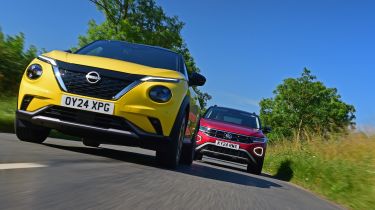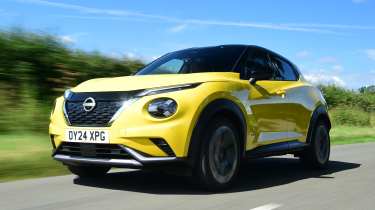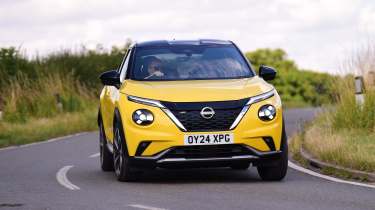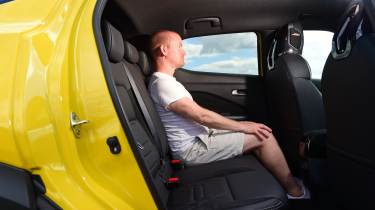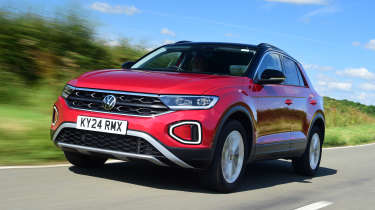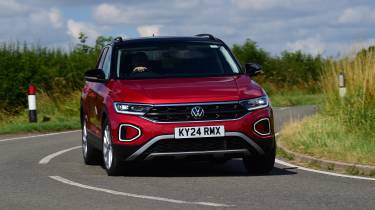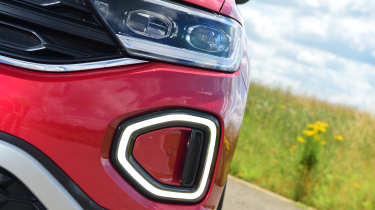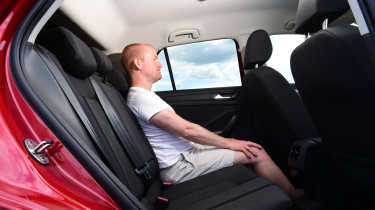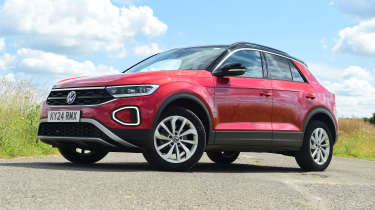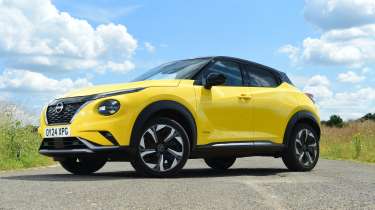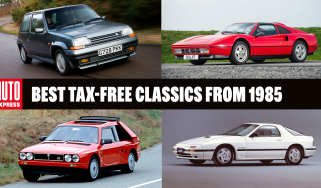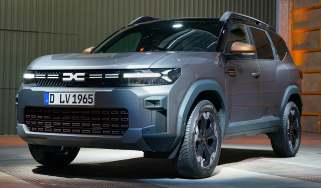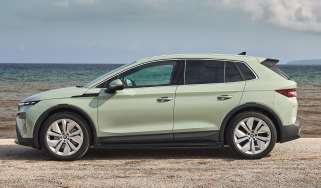Nissan Juke vs Volkswagen T-Roc: small SUVs fight for family car honours
Small SUVs from Nissan and Volkswagen battle it out to determine which is the best option for everyday family life
For car manufacturers, small SUVs are big business these days, and it’s arguable that the original Nissan Juke kick-started the class and subsequent sales successes. The second-generation model has just been updated with the introduction of a new hybrid powertrain that aims to boost performance and efficiency, but does it achieve those two aims?
To find out, we’re pitching it against another small SUV that delivers strong sales results for its manufacturer – the Volkswagen T-Roc. There’s no hybrid tech here, but the company’s 1.5 TSI motor is still an efficient performer, while the T-Roc is a strong all-round package for the Juke to go up against. We’ll focus on the everyday usability and efficiency of these two models as part of our Real-World Road Test, as well as crunching the numbers in terms of finances.
| Nissan Juke Hybrid 143 Tekna+ | Volkswagen T-Roc 1.5 TSI DSG Match | |
| Price: | £31,995 | £31,815 |
| Powertrain: | 1.6-litre 4cyl petrol hybrid, 141bhp | 1.5-litre 4cyl turbo petrol, 148bhp |
| 0-62mph: | 10.1 seconds | 8.4 seconds |
| Test efficiency: | 49.7mpg/10.9mpl | 46.3mpg/10.2mpl |
| CO2: | 109g/km | 137g/km |
| Annual VED: | £180 | £190 |
Nissan Juke
An update introduced earlier in 2024 saw yellow return to the Nissan Juke’s colour options, but most of the other changes took place inside, although the hybrid powertrain is now offered across a broader range of trim levels. The hybrid we’re testing here is in top-spec Tekna+ guise.
Tech highlights
The Nissan Juke is based on the same CMF-B platform as sister brand Renault’s Captur, and Nissan’s hybrid system uses a variation of the French car’s petrol-electric powertrain. Here it comprises a 93bhp 1.6-litre naturally aspirated petrol engine and a 48bhp electric motor, and together these make a combined 141bhp.
More reviews
Car group tests
In-depth reviews
Road tests
- Nissan Juke N-Sport hybrid review: welcome changes inside, but dull to drive
- Nissan Juke (Mk1, 2010-2019) icon review: a divisive trailblazer
- New Nissan Juke Hybrid 2022 review
Used car tests
The Juke’s drive battery is a modest 1.2kWh unit that’s connected to a 15kW starter-generator, while Nissan’s ‘multi-mode’ transmission sends power to the front wheels. This features six ‘gears’ – four for the engine, two for the electric motor – and the car’s electronics manage energy flow between the different parts of the powertrain.
In everyday driving the car’s electronics favour the electric part of the system as often as possible, even at motorway speeds. A small green ‘EV’ light illuminates on the digital dashboard when the engine isn’t running, and this bias towards electricity has clear benefits for the Juke’s fuel economy.
Safety: The pre-facelift Juke earned a five-star Euro NCAP rating in 2019, while the arrival of the new car introduces some additional safety kit. The brake lights now flash when the driver makes a sudden and heavy application, while a driver-alertness system can monitor if you need a break from being at the wheel. Lane-departure warning and lane assist now come as standard on Tekna models and above.
On the road
It’s not sensational to drive, but the Juke is competent enough in every situation, and is helped by the smooth hybrid powertrain.
Around town: Rear visibility is fine when driving, but small windows and thick pillars mean the reversing camera and rear sensors are needed when parking. And due to the Nissan Juke’s rounded shape, you’re reliant on the front parking sensors to judge where the nose is relative to your surroundings.
At least the transmission is smooth, with the electric drive system doing most of the work. The engine only really cuts in when you ask for more power, and it does so smoothly. The 19-inch wheels fitted to Tekna cars and above add fidget to the Juke’s ride that remains present at all speeds.
A & B-roads: The Nissan Juke is nimble at higher speeds, but it’s hardly what you’d call fun. Light steering contributes to an easygoing nature when driving in town, but there’s no feedback from the wheel and the steering remains light as you go faster. At least body roll is kept in check quite well.
The Sport drive mode favours the petrol engine over electric power, but the gearbox behaves like a CVT unit, so engine revs have no bearing on the car’s acceleration. A 0-62mph time of 10.1 seconds is 1.7 seconds behind the T-Roc’s, even though the cars weigh a similar amount and the Volkswagen is only 7bhp more powerful. The Nissan delivers its maximum power at far higher revs, though.
Motorway: Try to get up to motorway speeds as quickly as possible and the engine revs soar, but the Juke is fairly refined once you’re cruising. There’s some wind noise from the door mirrors, but the engine is quiet, and can even drop into EV mode when coasting.
Ownership
The main changes for the updated Juke focus on the interior, and chief among the updates are a revised infotainment screen and new air vents. Not only is the screen larger at 12.3 inches across, it’s also been subtly turned towards the driver by eight degrees to ensure the far corners of the display are still within easy reach.
The old car’s trio of circular air vents underneath the main screen have been swapped for a pair of oblong items, but below that the Juke’s physical climate buttons and knobs have been retained. We’re glad that Nissan hasn’t moved them to the touchscreen, because while they’re set low on the dashboard, they’re easy to locate and use without taking your eyes off the road.
N-Connecta cars and above now come with a second 12.3-inch display that’s ahead of the driver. This replaces the old car’s analogue dials and compact trip computer, but the graphics and interface are the same as before, so although the tech is new, there’s plenty of familiarity. It allows navigation information to be displayed directly ahead, among other options, and is controlled via the steering wheel as before. That wheel is carried over from the old car, as are the outer air vents and centre console from the drive selector back.
Elsewhere, there’s some Alcantara trim for higher-spec models that gives the cabin a lift, while part-artificial leather adds a sporty feel, too. Cabin quality is good, although the gloss- black trim on the centre console is likely to get scratched easily in everyday use.
Storage: The Juke’s door bins are an area where sacrifices have been made to boost interior space. The front ones are short and the rears are only big enough for a bottle and a small snack, while both lose space to the speakers that are moulded into the doors. The centre armrest bin is awkwardly tall and square, but the glovebox is reasonable.
Practicality
Compact dimensions and small windows make the Juke feel claustrophobic.
Rear space: As if to prove that the Juke isn’t very big in the back, it doesn’t have a fold-down centre armrest in the middle seat. There’s a seatbelt, but shoulder space will be tight if you’re travelling three-up.
Foot space is fine under the front seats, if a little narrow, but the high floor and low, short seat base mean there isn’t much under-thigh support. The seat backs are rather upright, too.
Boot: A high load lip is the first obstacle to overcome when loading the Nissan with luggage, while the opening isn’t as wide as the VW’s. The false floor is a handy addition, and creates a level platform when the back seats are folded. The storage space beneath is deep, and the false floor can sit on top of the lower level when you want to maximise space.
What to buy?
Which engine and trim we’d choose
- Engines: There are two engine options in the Juke line-up, with the 1.2 DiG-T manual kicking the range off at £23,500. This can be had with a DCT twin-clutch auto for £1,500 extra, while the Hybrid model starts from £27,095.
- Trim: All three engines are available in every spec. Acenta Premium is the entry-level trim, with the range running through N-Connecta, Tekna, Tekna+ and N-Sport. It’s £2,000 to upgrade from Acenta Premium to N-Connecta, and Tekna is £1,500 extra. Tekna+ is another £1,400 on top of that, while N-Sport is the same price.
- Our choice: We’d spend a little extra on Tekna to get the full Safety Shield pack.
Volkswagen T-Roc
While we’re assessing the top-spec Juke here, Match trim on the Volkswagen T-Roc is a special edition that slots in just above the entry-level Style model. We’re testing it with a DSG automatic gearbox for consistency when compared with the Nissan, although the T-Roc in our pictures features VW’s six-speed manual.
Tech highlights
The T-Roc is based on the VW Group’s tried-and-tested MQB scalable architecture for transverse engines, and it shares common parts with the SEAT Ateca, Skoda Karoq and Audi Q2. As with those cars, front and four-wheel-drive set-ups are offered, while this 148bhp model comes with a torsion beam rear suspension system, as opposed to the more sophisticated multi-link set-up found on more powerful models and those with four-wheel drive.
Full hybrid technology is still a rarity in the Volkswagen line-up, but the T-Roc features useful fuel-saving measures. Stop-start is fitted, and in the auto model this automatically engages when you come to a halt. VW’s Active Cylinder Technology (ACT) is also included, which shuts down half the cylinders when the engine is under light loads.
It’s a smooth set-up, because the only clue as to when it has engaged is an indicator on the dashboard. Claimed fuel economy for the DSG-equipped T-Roc is 46.8mpg on the WLTP test cycle, compared with 58.8mpg for the hybrid Juke.
Safety: All versions of the T-Roc feature adaptive cruise control with speed limiter as standard, because it’s integrated into the car’s autonomous emergency braking system. As with the Juke, while the passenger airbag can be deactivated if you want to fit a child seat, the only Isofix mounts are on the two outer rear seats.
On the road
The T-Roc’s MQB platform delivers decent handling and a comfortable ride.
Around town: While the T-Roc is larger than the Juke, it’s no harder to manoeuvre, courtesy of light steering, decent visibility and standard-fit parking sensors front and rear. There is some hesitancy away from the lights as the DSG gearbox feeds power to the front wheels – the Juke uses its electric drive to fill in the torque curve while the engine gets up to speed. On the move, the T-Roc suffers from a bit of lag at lower speeds as the revs rise and the turbocharger engages, but keep them up and the car delivers decent acceleration.
A & B-roads: The T-Roc’s stronger power delivery means it feels more flexible than the Nissan, while the gearbox delivers smooth shifts. As with other VW models, the transmission likes to shift up early to help fuel economy, but press the accelerator a little harder and the car holds on to the ratios for longer.
The nimble MQB platform helps the VW to deliver decent handling, while the suspension offers a good balance between roadholding and comfort. In many ways it handles like a high-riding Golf – there’s some body roll when pushing harder, but the car feels stable and offers plenty of grip. VW’s electronic diff lock helps here by gently braking the inside wheel when cornering to help tuck the car’s nose into the turn.
Motorway: While the Juke revs its head off when getting up to the motorway limit, the VW is more measured and the sounds from under the bonnet are in sync with the car as it accelerates. Once up to speed, the T-Roc is refined and comfortable, and the ride becomes smoother the faster you go.
Ownership
An update in 2022 addressed some of the disappointing cabin quality that featured in the T-Roc when it was launched in 2018. At the same time, this helped to distance the car from the Taigo coupé-SUV, which slotted into the VW SUV line-up between the T-Cross and T-Roc in 2021.
It wasn’t that the layout was poor, but some of the materials used didn’t seem to be up to VW’s usual high standards. The current car feels better, with more soft-touch plastics in key areas, although some of the cabin layout is still disappointing. The climate controls, for example, feature buttons that are set low down on the dashboard. They’re in a similar location to the Nissan’s, but because they’re touch sensitive, they’re harder to use accurately when you’re on the move. At least the steering wheel features physical buttons, rather than the touch controls that were part of the VW Golf’s cabin up until the recent update, and they are straightforward to operate.
These two cars are fairly evenly matched for after-sales back-up. Both come with three-year/60,000-mile warranties and 12 months of breakdown cover. VW offers an extended warranty for up to two additional years at extra cost, while Nissan adds another 12 months of roadside assistance every time you get your car serviced at an official franchise.
Storage: The T-Roc has larger dimensions than the Juke, which means there are better storage solutions in the cabin. The glovebox is big and the door bins are deep – the rears are nearly the same size as the ones up front – although disappointingly they’re not flock-lined, as they are in some other VW models, so loose items do rattle around.
The centre console features twin cup-holders, a slot for a phone, and a tray ahead of the gear lever that’s right next to the USB sockets, so you don’t need to have cables trailing across the cabin.
Practicality
The T-Roc is only slightly larger than its Juke rival, but it has better packaging.
Rear space: Legroom in the back of the T-Roc is actually in shorter supply than in the Juke, but that’s because the seat bases are longer, and the additional under-thigh support means it’s more comfortable.
The VW’s transmission tunnel is taller than the Juke’s, too, so middle-seat foot space is slightly restricted, but shoulder space is good, and the VW is the better choice if you’re travelling with three in the back. As with the Nissan, there are a pair of USB sockets on offer, but the T-Roc also adds a couple of air vents.
Boot: A lower load lip, wider opening and larger floor area give the VW a clear advantage over its rival here, while the back seats fold in a 60:40 split and also feature a ski hatch for loading longer items.
What to buy?
Which engine and trim choice we’d choose
- Engines: VW offers 1.0, 1.5 and 2.0 TSI petrol and 2.0 TDI diesel engines in the standard T-Roc range, with the latter coming in different power outputs and the largest-capacity units offered with four-wheel drive.
- Trim: There are Life, Match, Style, R-Line, Black Edition and R models offered, although not every engine is available in every spec. R-Line and Black (which is a styling upgrade over R-Line) only offer 1.5 and 2.0-litre engines, for example. Style has the widest range of engine choices, although Match spec offers better value for money.
- Our choice: Four-wheel drive seems unnecessary, we’d stick with the 1.5 TSI DSG Match.
Results
Which car comes out on top?
Winner: Volkswagen T-Roc
The big advantage that the Volkswagen T-Roc has over the Nissan Juke is the space that it offers. Its exterior dimensions are manageable, but there’s enough space on board that it can be considered a practical family car.
While the 1.5 TSI engine isn’t the most efficient unit around, and it’s not as smooth as the Nissan’s hybrid system, it still offers plenty of pulling power and the DSG gearbox is a slick shifter. It has a decent balance between handling and comfort, too.
| Pros | Cons |
| Decent space | Fiddly climate controls |
| Responsive engine | Hesitancy at lower revs |
| Smooth DSG gearbox | Petrol engine's efficiency |
| Comfortable ride | Doesn't offer much over a Golf |
Runner up: Nissan Juke
There’s no doubt that the hybrid powertrain is the best option in the updated Nissan Juke – it’s smooth and efficient, and while it doesn’t have the torque of the T-Roc, it’s well suited to most driving situations, as long as you don’t try to extend it too much. The new infotainment tech is well integrated, too.
But in this test, the Juke’s long-standing shortcomings in terms of passenger and boot space can’t be ignored, and mean it’s narrowly edged out by the T-Roc.
| Pros | Cons |
| Well integrated hybrid | Small boot |
| Lots of equipment | Tight back seats |
| Good economy | Fidgety ride |
| Decent infotainment | Harsh engine when revved |
Rivals and other options
T-Roc wins our twin test, but what else is out there?
- Same class: Renault Captur
- Same money: SEAT Arona
- Used: Volkswagen Tiguan
- Used: Nissan Qashqai
- Coming soon: Citroen C3 Aircross
The great debate
What the Auto Express team would do
John McIlroy, editor-at-large: “If you’re a fan of the bright-yellow finish of the Juke in our test, then new N-Sport trim could be for you. It adds a yellow flash across the top of the dashboard (although how it reflects in the windscreen remains to be seen), plus yellow stitching and seat trim.”
Richard Ingram, deputy editor: “It’s good to see that Nissan is reviving the sporting Nismo badge with the Ariya electric SUV, but if there are plans for a revival of the Juke Nismo, it’ll need to be a lot better than the old one. That car was too uncomfortable to be practical and failed to deliver the ability of a performance model.”
Dawn Grant, picture editor: “I’m all for adventurous design, but the Juke has always delivered out-there styling that sacrifices everyday practicality. If you don’t need the back seats for carrying a family, then it makes more sense, but do you really need a small SUV? If not, a coupé or convertible would offer the same versatility.”
Paul Barker, editor: “The crossover between VW’s range of SUVs means there should be a car to suit most needs and budgets. However, if you can stretch to a T-Roc over a T-Cross or Taigo, we’d recommend it – the larger car is better to drive, has more space and is almost as economical.”
Alex Ingram, chief reviewer: “There are a lot of similarities between the T-Roc and the Golf, but not all of them are positives. Take the tailgate as an example. The T-Roc’s opens wide, but like the Golf’s it needs quite a slam to shut properly – the dashboard warning being the only clue that it hasn’t latched.”
| Nissan Juke Hybrid 143 Tekna+ | Volkswagen T-Roc 1.5 TSI DSG Match | |
| On the road price/as tested | £31,995/£32,115 | £31,815/£31,815 |
| Powertrain | 4cyl in-line petrol hybrid/1,598cc | 4cyl in-line turbo petrol/1,498cc |
| Power/torque | 141bhp/148Nm | 148bhp/250Nm |
| Transmission | Six-speed auto/fwd | Seven-speed auto/fwd |
| Fuel tank capacity | 46 litres | 50 litres |
| Length/wheelbase | 4,210/2,636mm | 4,236/2,590mm |
| Height/width | 1,593/1,800mm | 1,584/1,819mm |
| Boot capacity (seats up/down) | 354/1,237 litres | 445/1,290 litres |
| Kerbweight/payload/towing weight | 1,348/387/750kg | 1,355/495/1,500kg |
| Turning circle/spare wheel | 10.6 metres/£130 | 10.9 metres/£300 |
| Basic warranty (miles)/recovery | 3yrs (60,000)/1yr | 3yrs (60,000)/1yr |
| Driver Power maker position | 19th | 27th |
| NCAP: Adult/child/ped./assist/stars | 94/85/81/73/5 (2019) | 96/87/79/71/5 (2017) |
| 0-62mph/top speed | 10.1 seconds/103mph | 8.4 seconds/129mph |
| Auto Express economy/range | 49.7mpg/503 miles | 46.3mpg/509 miles |
| WLTP combined | 58.8mpg | 46.8mpg |
| WLTP combined | 12.9mpl | 10.3mpl |
| Actual/claimed CO2/tax bracket | 131/109g/km/26% | 141/137g/km/32% |
| Number of airbags/Isofix points | Six/two | Six/two |
| Parking sensors/camera | Front & rear/360 degrees | Front & rear/yes |
| Lane-keep assist/blindspot/AEB | Yes/yes/yes | Yes/no/yes |
| Climate control/cruise control | Yes/yes | Two-zone/yes |
| Leather/heated seats/wheel | Part/yes/yes | No/£375 Winter pack/£310 |
| Metallic paint/LED lights | £120/yes | Yes/yes |
| Keyless entry & go/powered tailgate | Yes/no | Yes/no |
| Sat-nav/digital dashboard/USBs | Yes/yes/four | £810/yes/four |
| Online services/wireless charging | Yes/yes | Yes/£300 |
| Apple CarPlay/Android Auto | Wireless/wireless | Wireless/wireless |

